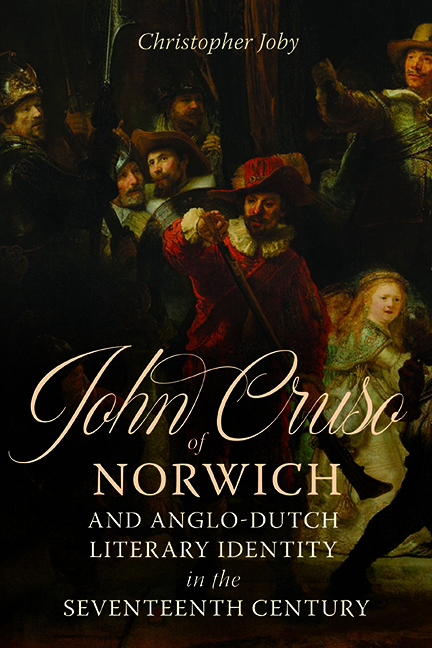Book contents
- Frontmatter
- Dedication
- Contents
- List of illustrations
- Acknowledgements
- Author’s note
- Abbreviations
- Prologue
- 1 Intrat John Cruso
- 2 John Cruso’s school days
- 3 John Cruso’s early adult life
- 4 Cruso’s elegy to Simeon Ruytinck (1622)
- 5 Cruso the English poet
- 6 1632 – Cruso’s annus mirabilis
- 7 Cruso the translator
- 8 Cruso’s 1642 Dutch verses: praise and lamentation
- 9 Cruso and the English Civil Wars
- 10 Cruso the Epigrammatist
- 11 Cruso’s final years
- Epilogue
- Appendix 1 Poems by John Cruso
- Appendix 2 Liminary verses in John Cruso’s English publications
- Bibliography
- Index
- Studies in Renaissance Literature
6 - 1632 – Cruso’s annus mirabilis
Published online by Cambridge University Press: 26 May 2022
- Frontmatter
- Dedication
- Contents
- List of illustrations
- Acknowledgements
- Author’s note
- Abbreviations
- Prologue
- 1 Intrat John Cruso
- 2 John Cruso’s school days
- 3 John Cruso’s early adult life
- 4 Cruso’s elegy to Simeon Ruytinck (1622)
- 5 Cruso the English poet
- 6 1632 – Cruso’s annus mirabilis
- 7 Cruso the translator
- 8 Cruso’s 1642 Dutch verses: praise and lamentation
- 9 Cruso and the English Civil Wars
- 10 Cruso the Epigrammatist
- 11 Cruso’s final years
- Epilogue
- Appendix 1 Poems by John Cruso
- Appendix 2 Liminary verses in John Cruso’s English publications
- Bibliography
- Index
- Studies in Renaissance Literature
Summary
So, we reach 1632, John Cruso's annus mirabilis. By now, Cruso was approaching his fortieth birthday. He had moved up a social notch to the parish of St Peter Mancroft and his eldest son, John, matriculated at Cambridge. His experience as a militia captain in Norwich allowed him to adopt a new authorial voice, that of the military author, and in that signal year he published his statement of socio-cultural self-fashioning par excellence, Militarie Instructions for the Cavallrie. Although this is, above all, an instruction manual on horsemanship, its form and content allow us to explore several themes of current interest in scholarship, such as cultural production, cultural transfer, patronage, gift-giving, and the author–publisher relationship. The chapter begins by placing Cruso's book in the broader context of military publishing in late Tudor and early Stuart England. Important conversation partners here are the military historians Barbara Donagan, David Lawrence, and Ismini Pells. It then analyzes the manifold sources that Cruso uses in his book. In the Letter to the Reader alone, there are eighteen quotations in the main text and margin, many in the original Latin. Cruso's frequent appeal to classical and post-classical authors forms part of his programme of positioning himself as a miles doctus, a man skilled in war and words. Cruso dedicated the work to Thomas Howard, Earl of Arundel. The chapter analyzes why Arundel was such a judicious choice as dedicatee and what this choice tells us about patronage in Cruso's work. It also analyzes Cruso's relationship with the printer, Roger Daniel, and the engraver, Cornelis van Dalen. After a detailed analysis of the Letter to the Reader, the chapter analyzes aspects of the main text of Militarie Instructions, including its structure, content, and language. The chapter concludes by analyzing the reception of Militarie Instructions. A mark of its success is that a second edition was published in 1644. This is analyzed in Chapter 9.
Before going any further, one question to address is whether Militarie Instructions was the first military work that Cruso published. Until recently, it was thought that this was the case.
- Type
- Chapter
- Information
- Publisher: Boydell & BrewerPrint publication year: 2022



